NRSG 138: Analyzing Roach's 6Cs & NMBA Code of Conduct Relation
VerifiedAdded on 2023/04/25
|6
|848
|295
Report
AI Summary
This report provides a rationale for the relationship between Roach's 6Cs of caring (Care, Competence, and Communication) and the NMBA (Nursing and Midwifery Board of Australia) Code of Conduct, within the context of NRSG 138: Transition to Nursing at the Australian Catholic University. It emphasizes how these selected 3Cs align with the NMBA standards for practice, including critical thinking, professional relationships, holistic assessment, and safe healthcare provision. The report further discusses the effects of integrating both the 6Cs and NMBA standards, ensuring ethical decision-making, respect for patients, and collaborative practice, all of which contribute to improved patient outcomes. The document includes relevant references to support its analysis and conclusions.
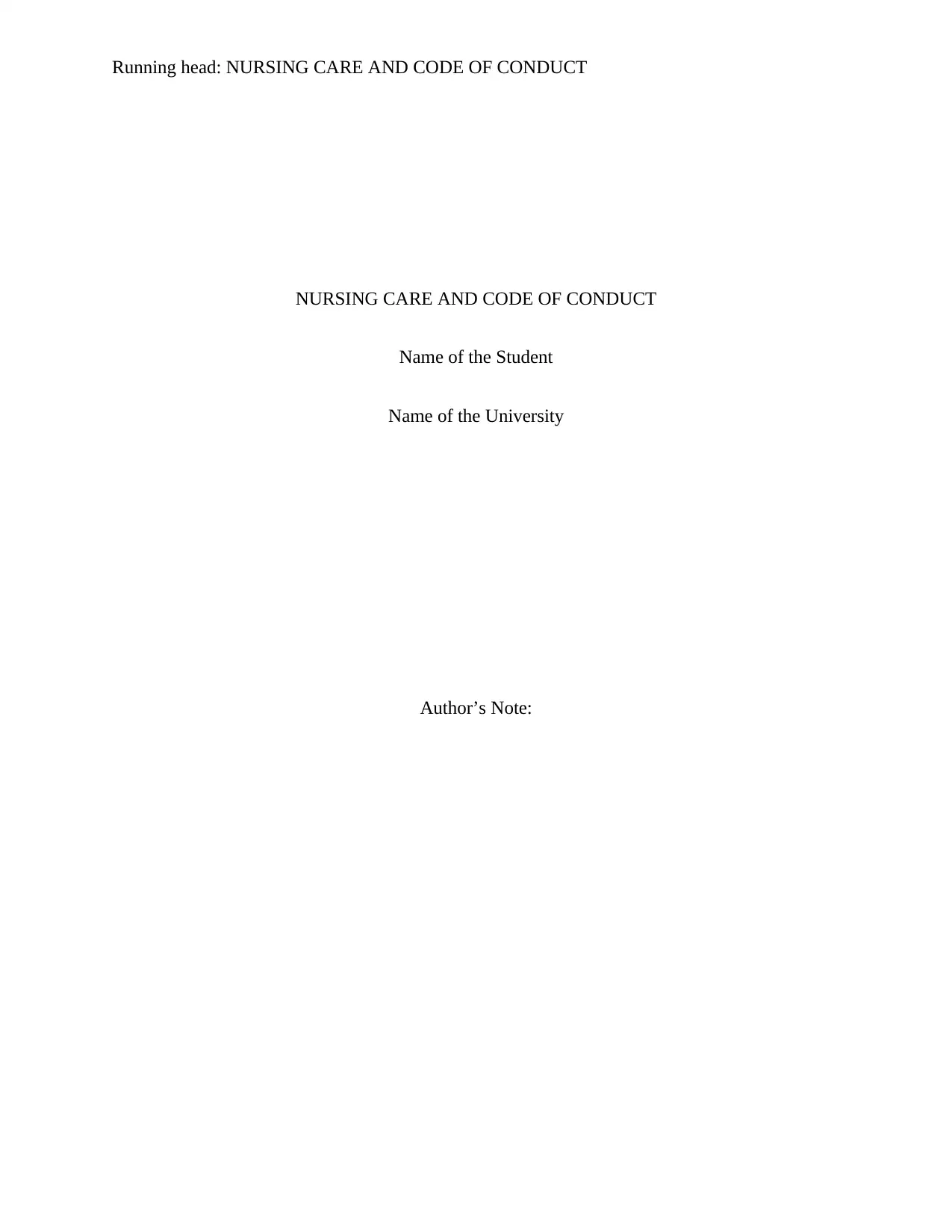
Running head: NURSING CARE AND CODE OF CONDUCT
NURSING CARE AND CODE OF CONDUCT
Name of the Student
Name of the University
Author’s Note:
NURSING CARE AND CODE OF CONDUCT
Name of the Student
Name of the University
Author’s Note:
Paraphrase This Document
Need a fresh take? Get an instant paraphrase of this document with our AI Paraphraser
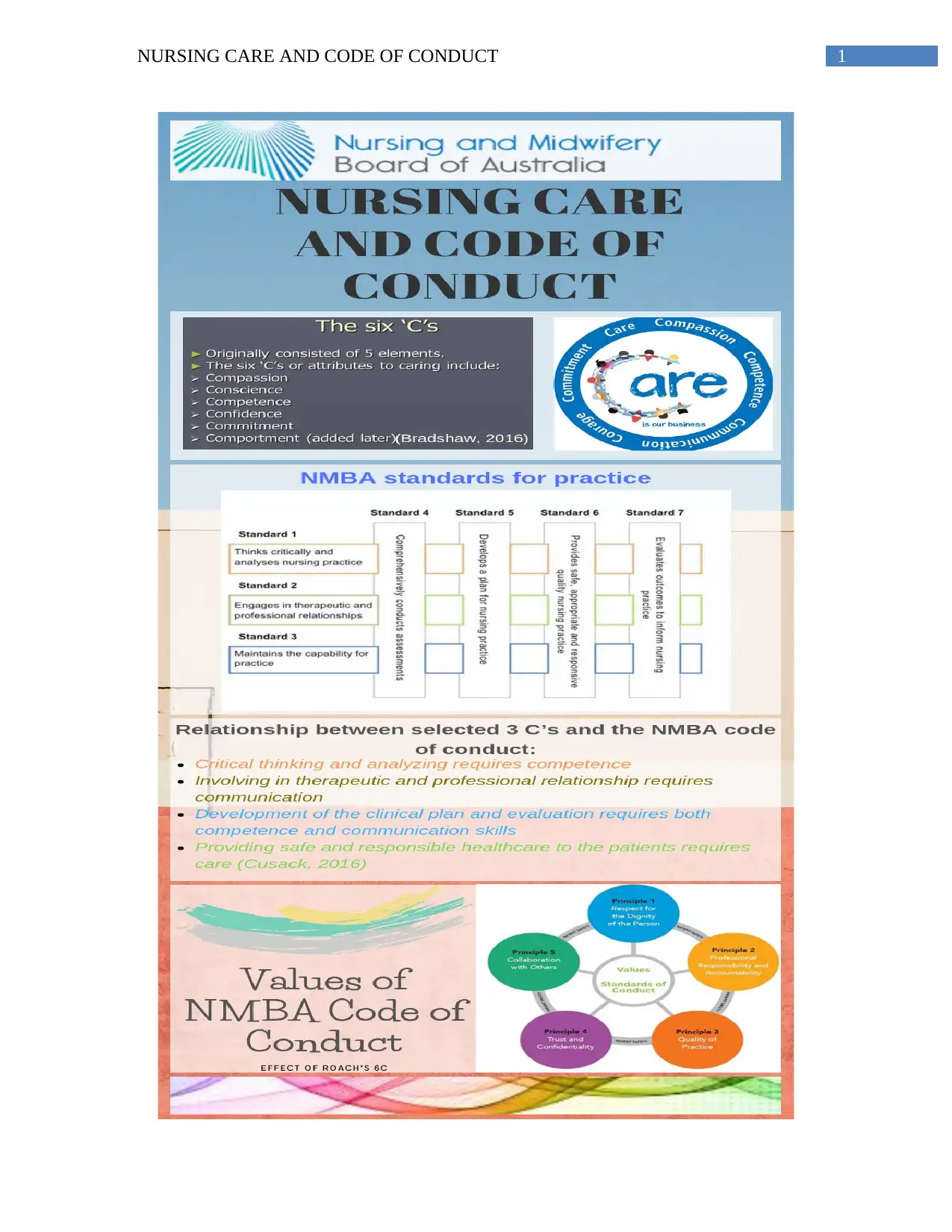
1NURSING CARE AND CODE OF CONDUCT
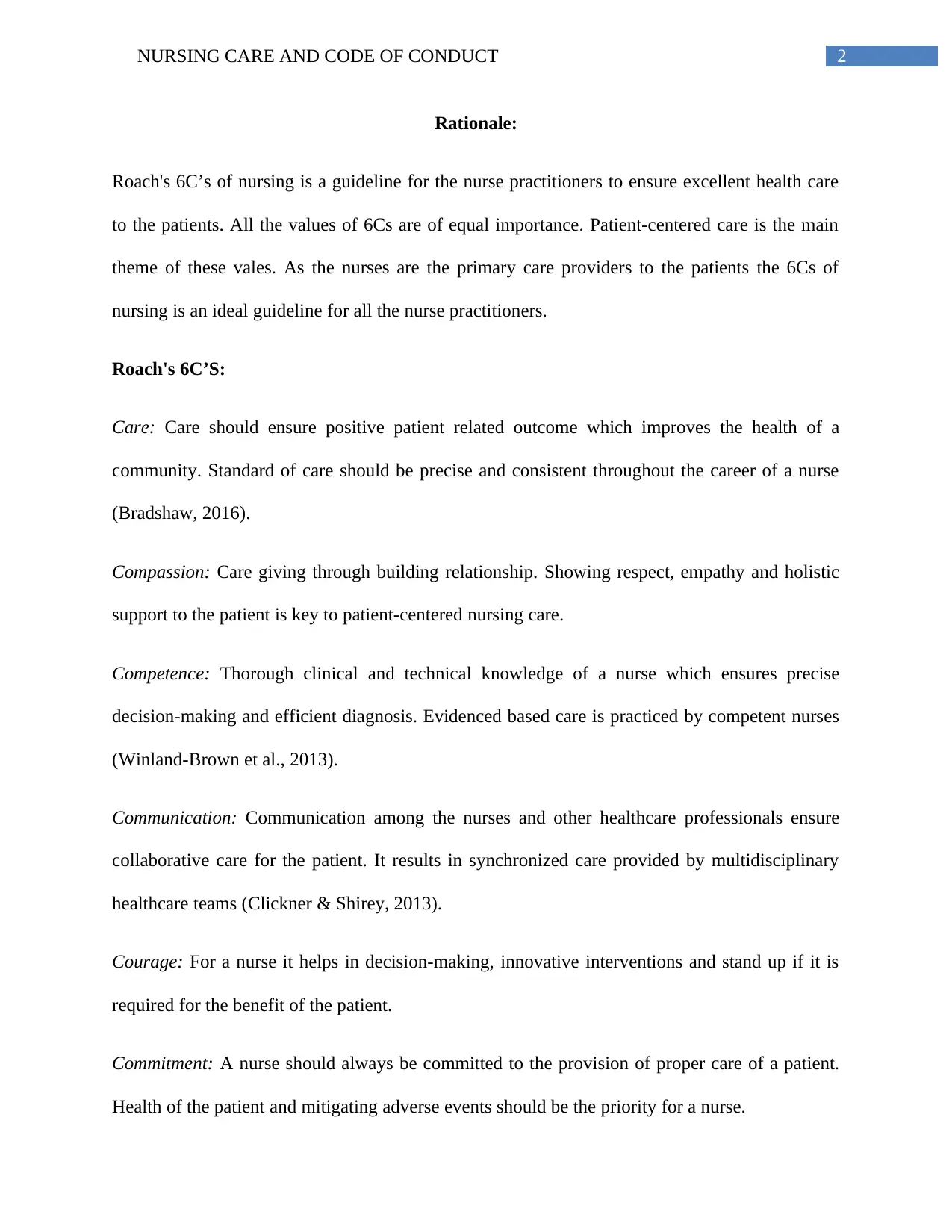
2NURSING CARE AND CODE OF CONDUCT
Rationale:
Roach's 6C’s of nursing is a guideline for the nurse practitioners to ensure excellent health care
to the patients. All the values of 6Cs are of equal importance. Patient-centered care is the main
theme of these vales. As the nurses are the primary care providers to the patients the 6Cs of
nursing is an ideal guideline for all the nurse practitioners.
Roach's 6C’S:
Care: Care should ensure positive patient related outcome which improves the health of a
community. Standard of care should be precise and consistent throughout the career of a nurse
(Bradshaw, 2016).
Compassion: Care giving through building relationship. Showing respect, empathy and holistic
support to the patient is key to patient-centered nursing care.
Competence: Thorough clinical and technical knowledge of a nurse which ensures precise
decision-making and efficient diagnosis. Evidenced based care is practiced by competent nurses
(Winland-Brown et al., 2013).
Communication: Communication among the nurses and other healthcare professionals ensure
collaborative care for the patient. It results in synchronized care provided by multidisciplinary
healthcare teams (Clickner & Shirey, 2013).
Courage: For a nurse it helps in decision-making, innovative interventions and stand up if it is
required for the benefit of the patient.
Commitment: A nurse should always be committed to the provision of proper care of a patient.
Health of the patient and mitigating adverse events should be the priority for a nurse.
Rationale:
Roach's 6C’s of nursing is a guideline for the nurse practitioners to ensure excellent health care
to the patients. All the values of 6Cs are of equal importance. Patient-centered care is the main
theme of these vales. As the nurses are the primary care providers to the patients the 6Cs of
nursing is an ideal guideline for all the nurse practitioners.
Roach's 6C’S:
Care: Care should ensure positive patient related outcome which improves the health of a
community. Standard of care should be precise and consistent throughout the career of a nurse
(Bradshaw, 2016).
Compassion: Care giving through building relationship. Showing respect, empathy and holistic
support to the patient is key to patient-centered nursing care.
Competence: Thorough clinical and technical knowledge of a nurse which ensures precise
decision-making and efficient diagnosis. Evidenced based care is practiced by competent nurses
(Winland-Brown et al., 2013).
Communication: Communication among the nurses and other healthcare professionals ensure
collaborative care for the patient. It results in synchronized care provided by multidisciplinary
healthcare teams (Clickner & Shirey, 2013).
Courage: For a nurse it helps in decision-making, innovative interventions and stand up if it is
required for the benefit of the patient.
Commitment: A nurse should always be committed to the provision of proper care of a patient.
Health of the patient and mitigating adverse events should be the priority for a nurse.
⊘ This is a preview!⊘
Do you want full access?
Subscribe today to unlock all pages.

Trusted by 1+ million students worldwide
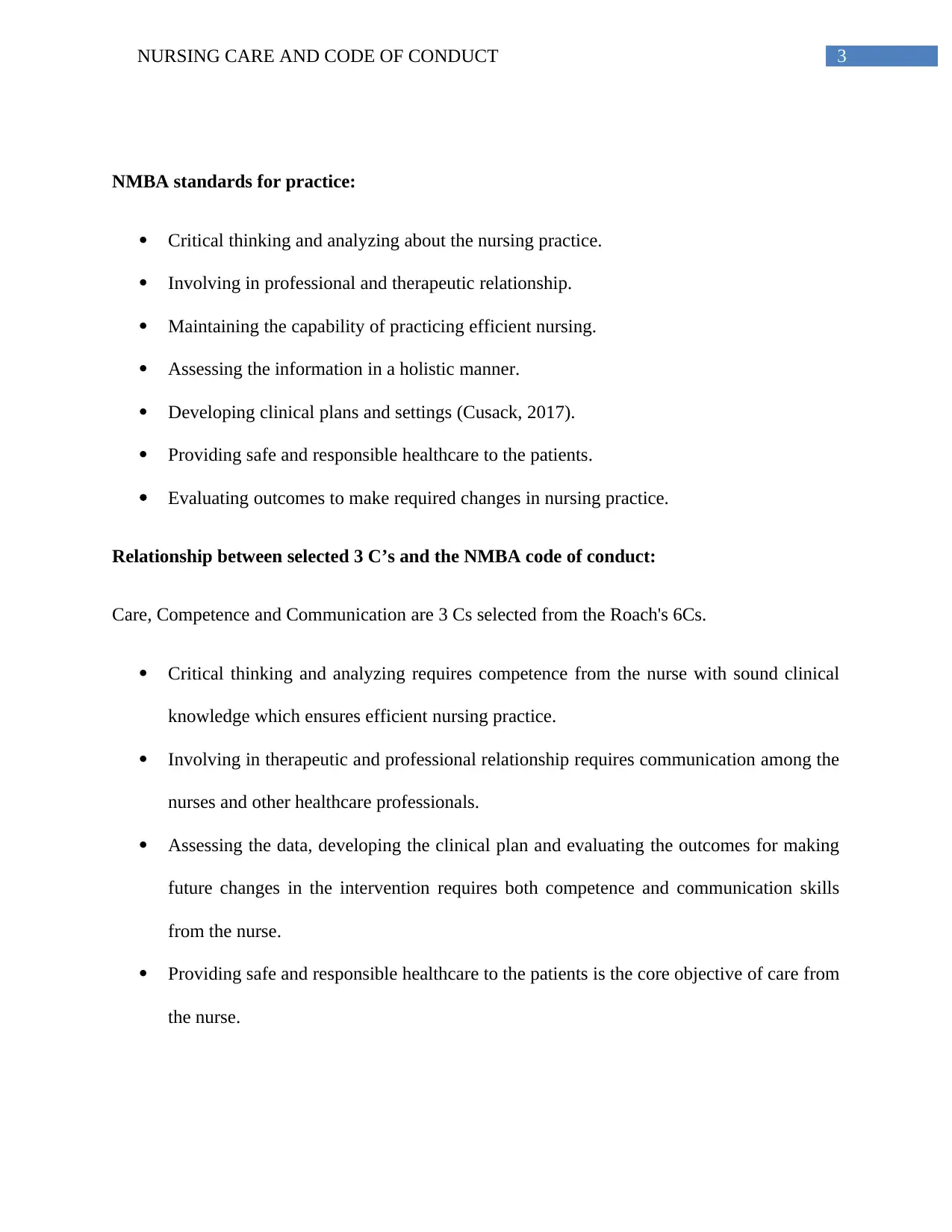
3NURSING CARE AND CODE OF CONDUCT
NMBA standards for practice:
Critical thinking and analyzing about the nursing practice.
Involving in professional and therapeutic relationship.
Maintaining the capability of practicing efficient nursing.
Assessing the information in a holistic manner.
Developing clinical plans and settings (Cusack, 2017).
Providing safe and responsible healthcare to the patients.
Evaluating outcomes to make required changes in nursing practice.
Relationship between selected 3 C’s and the NMBA code of conduct:
Care, Competence and Communication are 3 Cs selected from the Roach's 6Cs.
Critical thinking and analyzing requires competence from the nurse with sound clinical
knowledge which ensures efficient nursing practice.
Involving in therapeutic and professional relationship requires communication among the
nurses and other healthcare professionals.
Assessing the data, developing the clinical plan and evaluating the outcomes for making
future changes in the intervention requires both competence and communication skills
from the nurse.
Providing safe and responsible healthcare to the patients is the core objective of care from
the nurse.
NMBA standards for practice:
Critical thinking and analyzing about the nursing practice.
Involving in professional and therapeutic relationship.
Maintaining the capability of practicing efficient nursing.
Assessing the information in a holistic manner.
Developing clinical plans and settings (Cusack, 2017).
Providing safe and responsible healthcare to the patients.
Evaluating outcomes to make required changes in nursing practice.
Relationship between selected 3 C’s and the NMBA code of conduct:
Care, Competence and Communication are 3 Cs selected from the Roach's 6Cs.
Critical thinking and analyzing requires competence from the nurse with sound clinical
knowledge which ensures efficient nursing practice.
Involving in therapeutic and professional relationship requires communication among the
nurses and other healthcare professionals.
Assessing the data, developing the clinical plan and evaluating the outcomes for making
future changes in the intervention requires both competence and communication skills
from the nurse.
Providing safe and responsible healthcare to the patients is the core objective of care from
the nurse.
Paraphrase This Document
Need a fresh take? Get an instant paraphrase of this document with our AI Paraphraser
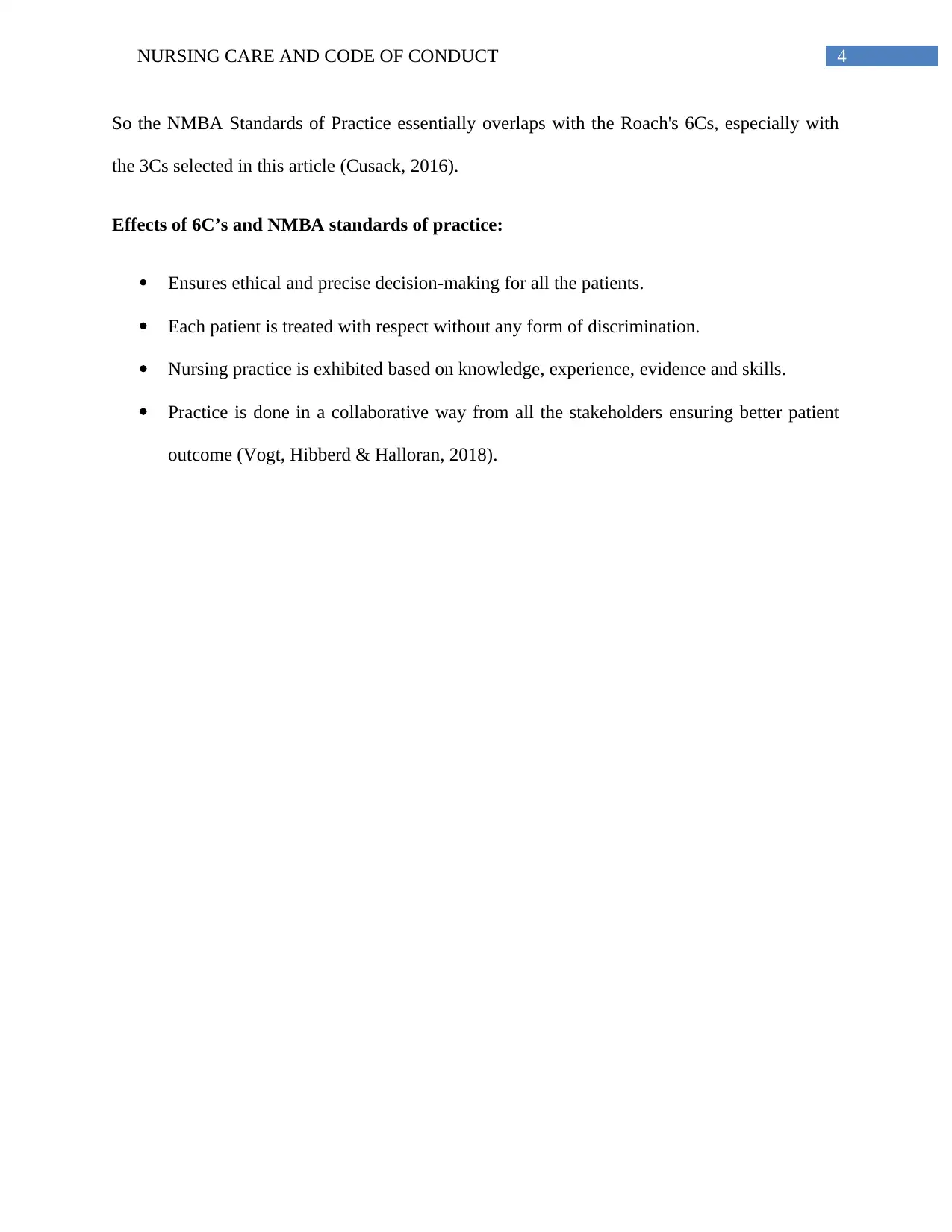
4NURSING CARE AND CODE OF CONDUCT
So the NMBA Standards of Practice essentially overlaps with the Roach's 6Cs, especially with
the 3Cs selected in this article (Cusack, 2016).
Effects of 6C’s and NMBA standards of practice:
Ensures ethical and precise decision-making for all the patients.
Each patient is treated with respect without any form of discrimination.
Nursing practice is exhibited based on knowledge, experience, evidence and skills.
Practice is done in a collaborative way from all the stakeholders ensuring better patient
outcome (Vogt, Hibberd & Halloran, 2018).
So the NMBA Standards of Practice essentially overlaps with the Roach's 6Cs, especially with
the 3Cs selected in this article (Cusack, 2016).
Effects of 6C’s and NMBA standards of practice:
Ensures ethical and precise decision-making for all the patients.
Each patient is treated with respect without any form of discrimination.
Nursing practice is exhibited based on knowledge, experience, evidence and skills.
Practice is done in a collaborative way from all the stakeholders ensuring better patient
outcome (Vogt, Hibberd & Halloran, 2018).
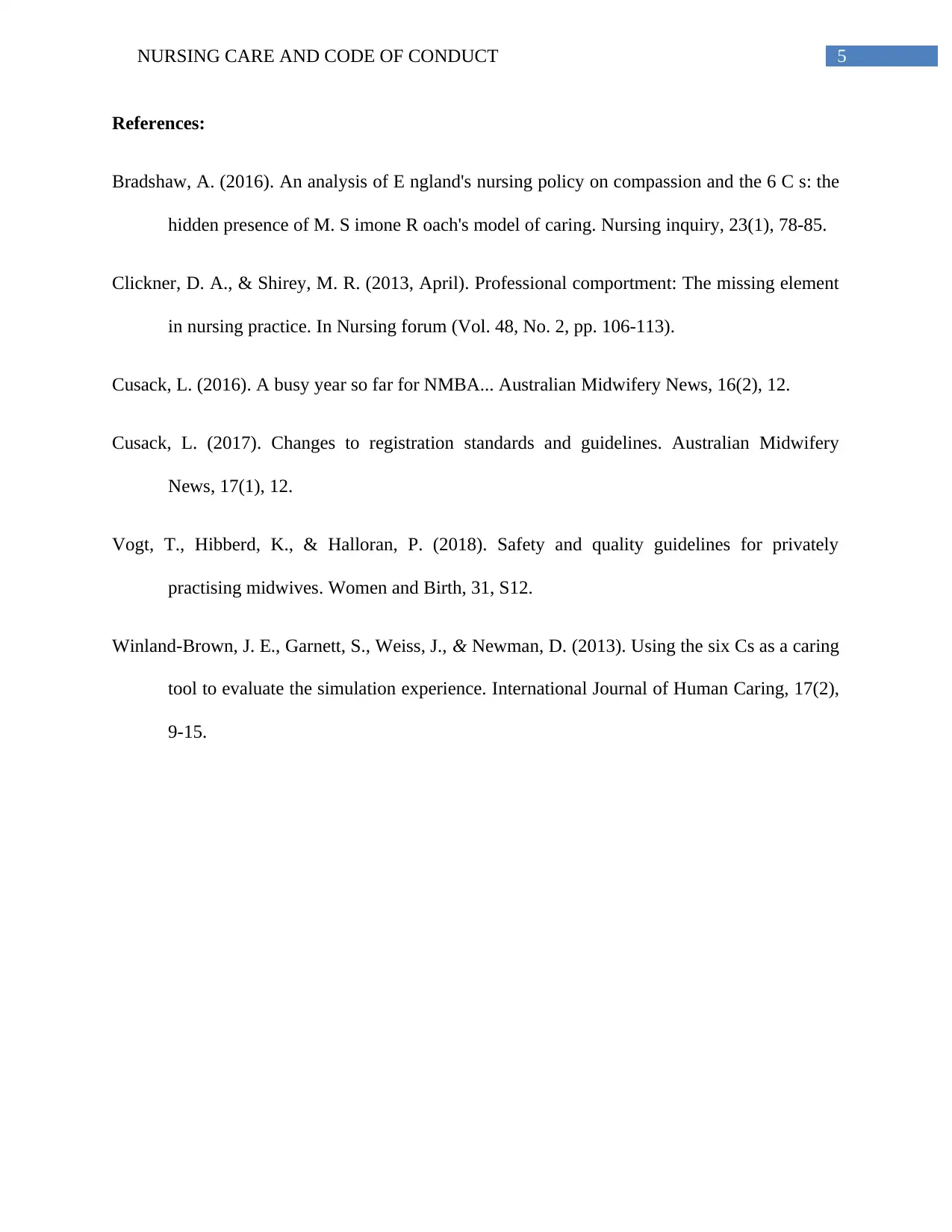
5NURSING CARE AND CODE OF CONDUCT
References:
Bradshaw, A. (2016). An analysis of E ngland's nursing policy on compassion and the 6 C s: the
hidden presence of M. S imone R oach's model of caring. Nursing inquiry, 23(1), 78-85.
Clickner, D. A., & Shirey, M. R. (2013, April). Professional comportment: The missing element
in nursing practice. In Nursing forum (Vol. 48, No. 2, pp. 106-113).
Cusack, L. (2016). A busy year so far for NMBA... Australian Midwifery News, 16(2), 12.
Cusack, L. (2017). Changes to registration standards and guidelines. Australian Midwifery
News, 17(1), 12.
Vogt, T., Hibberd, K., & Halloran, P. (2018). Safety and quality guidelines for privately
practising midwives. Women and Birth, 31, S12.
Winland-Brown, J. E., Garnett, S., Weiss, J., & Newman, D. (2013). Using the six Cs as a caring
tool to evaluate the simulation experience. International Journal of Human Caring, 17(2),
9-15.
References:
Bradshaw, A. (2016). An analysis of E ngland's nursing policy on compassion and the 6 C s: the
hidden presence of M. S imone R oach's model of caring. Nursing inquiry, 23(1), 78-85.
Clickner, D. A., & Shirey, M. R. (2013, April). Professional comportment: The missing element
in nursing practice. In Nursing forum (Vol. 48, No. 2, pp. 106-113).
Cusack, L. (2016). A busy year so far for NMBA... Australian Midwifery News, 16(2), 12.
Cusack, L. (2017). Changes to registration standards and guidelines. Australian Midwifery
News, 17(1), 12.
Vogt, T., Hibberd, K., & Halloran, P. (2018). Safety and quality guidelines for privately
practising midwives. Women and Birth, 31, S12.
Winland-Brown, J. E., Garnett, S., Weiss, J., & Newman, D. (2013). Using the six Cs as a caring
tool to evaluate the simulation experience. International Journal of Human Caring, 17(2),
9-15.
⊘ This is a preview!⊘
Do you want full access?
Subscribe today to unlock all pages.

Trusted by 1+ million students worldwide
1 out of 6
Related Documents
Your All-in-One AI-Powered Toolkit for Academic Success.
+13062052269
info@desklib.com
Available 24*7 on WhatsApp / Email
![[object Object]](/_next/static/media/star-bottom.7253800d.svg)
Unlock your academic potential
Copyright © 2020–2025 A2Z Services. All Rights Reserved. Developed and managed by ZUCOL.





